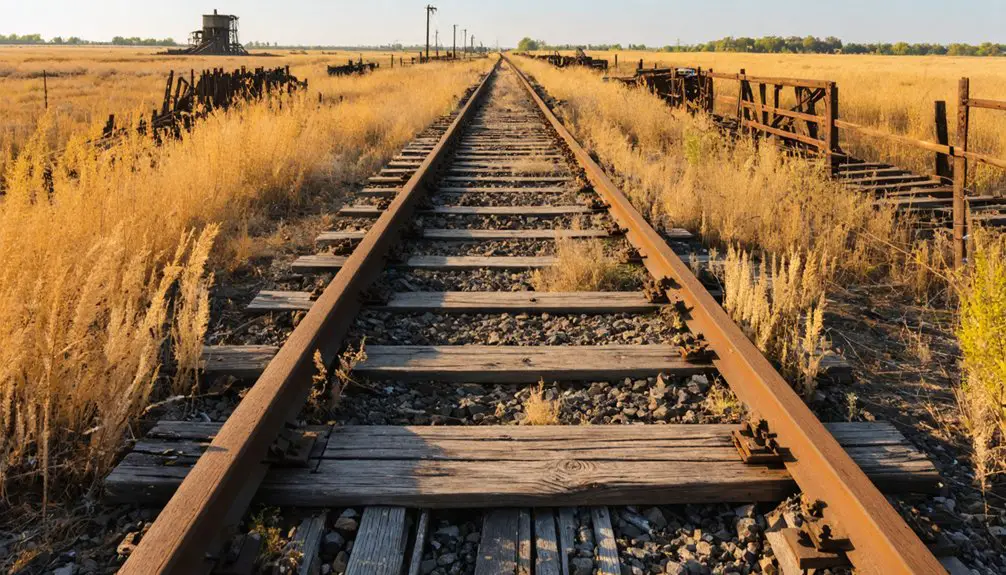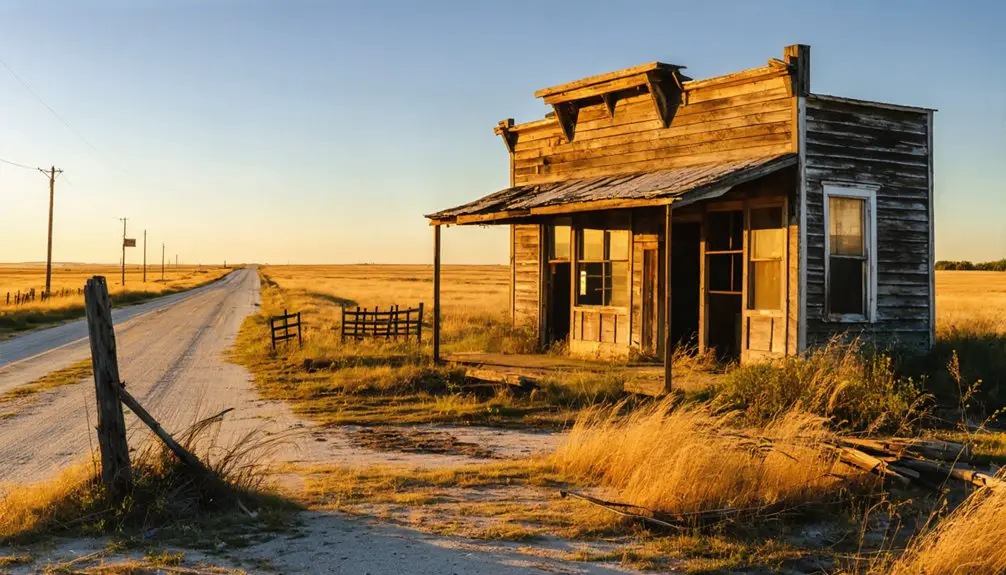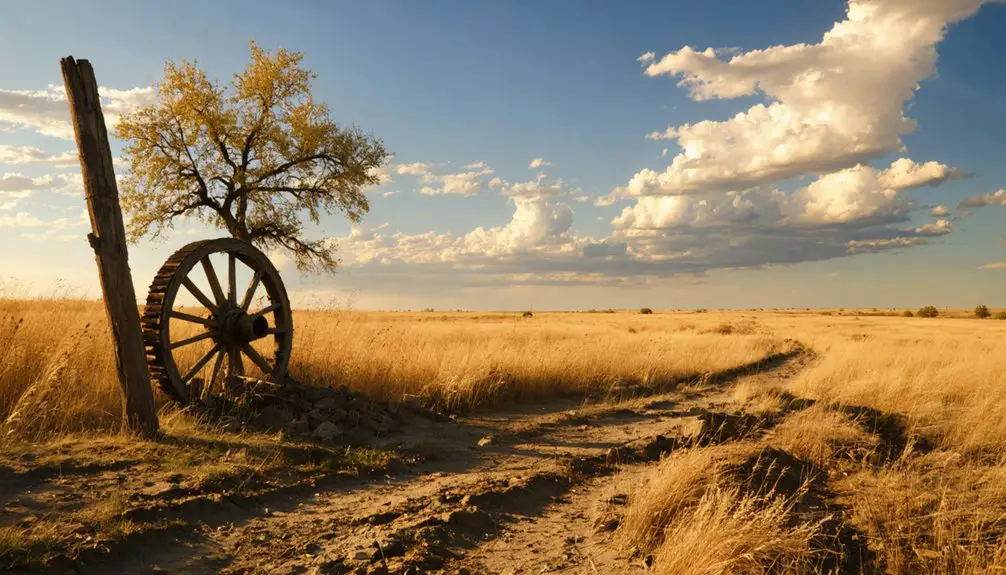You’ll find Trail City‘s remains two miles west of Coolidge, Kansas, on Colorado soil, where it flourished as a bustling cattle trade hub from 1874-1884. Founded by Martin S. Culver, this infamous border town handled over 300,000 cattle at its peak in 1881. Known as “the wickedest city in Colorado,” it attracted outlaws who exploited jurisdictional gaps between states. While its prosperity lasted only three years, Trail City’s wild legacy captures the raw essence of America’s frontier spirit.
Key Takeaways
- Trail City emerged in the late 1870s as a cattle trade hub along the Kansas-Colorado border, founded by Martin S. Culver.
- The town experienced rapid growth during 1874-1884, processing over 300,000 cattle at its peak in 1881.
- Known as “the wickedest city in Colorado,” Trail City struggled with lawlessness due to its border location and lack of enforcement.
- Competition from nearby Coolidge, which had better infrastructure and railroad access, contributed to Trail City’s eventual abandonment.
- Archaeological remains include building foundations, dugouts, and Martin Culver’s grave, preserving the town’s frontier history.
The Rise of a Border Settlement
During the late 1870s, Martin S. Culver founded Trail City, a settlement that embodied the raw spirit of border settlement dynamics along the Kansas-Colorado line.
Trail City emerged as a testament to frontier ambition, where state borders shaped the destiny of an untamed West.
You’ll find its remnants two miles west of Coolidge, Kansas, though Trail City itself stood firmly on Colorado soil.
The town’s strategic position made it a natural hub for the region’s cattle trade evolution, attracting drovers and traders who were pushing westward. The Santa Fe Trail passed nearby, bringing additional traffic and commerce through the area.
Like Kansas City’s growth after the Civil War, Trail City experienced a brief but intense period of cattle trade prosperity.
As a “brother city” to Coolidge, Trail City capitalized on its unique border location, offering quick escape routes across state lines for those seeking to evade law enforcement.
With minimal governmental oversight and fragmented jurisdiction between states, you’d have witnessed a settlement that thrived on its reputation for lawlessness – though this same characteristic would ultimately spell its doom within just three years.
Life on the Kansas-Colorado Line
You’d find yourself in a lawless frontier at Trail City, where criminals exploited the Colorado-Kansas border to evade arrest by simply stepping across state lines.
Similar to the Public Land Strip, the area became a haven for those seeking to operate beyond governmental control.
Like the Colorado Territory established in 1861, the town’s strategic position along major cattle trails made it both economically essential and notoriously dangerous, earning it the reputation as “the wickedest city in Colorado.”
The lack of cooperative law enforcement between the two states created perfect conditions for outlaws, who thrived alongside legitimate cattlemen and railroad workers in this brief but turbulent chapter of border town history.
Border Town Crime Sprees
Three factors made Trail City one of the most lawless towns along the Kansas-Colorado border in the late 1800s: its strategic location, weak law enforcement, and jurisdictional confusion.
You’d find criminals exploiting border law loopholes by simply stepping across state lines to evade arrest. The crime culture thrived as outlaws took advantage of poor coordination between Kansas and Colorado authorities.
The railroad’s presence near the border only intensified these problems. When the Atchison, Topeka, and Santa Fe Railway established its terminus nearby, it brought waves of transient populations looking for quick profits. The Santa Fe Trail traffic had initially contributed to the town’s rapid growth and development. Like the border queen city of Caldwell, Trail City’s proximity to territorial lines made it a hotbed for criminal activity.
Gambling dens, saloons, and brothels flourished, earning Trail City the title of “wickedest city in Colorado.” Without effective policing, criminals could easily escape by crossing into neighboring Coolidge, Kansas, making the town a perfect haven for outlaws.
Cattle Trail Border Life
Life along the Kansas-Colorado border transformed dramatically when the Western Trail emerged as a major cattle route in 1885, running parallel to the established Chisholm Trail but cutting through the western reaches of both states.
You’d find a bustling cattle culture where cowboys drove herds 15-20 miles daily, traversing essential water stops at places like Bluff Creek and the Arkansas River. An estimated six million cattle moved through this system during its active years.
The border’s strategic position shaped significant economic connections, as you could earn ten times more selling cattle in northern markets than in Texas. The trail’s economic impact was substantial, with Lytle’s investments totaling $9 million in livestock operations.
Dodge City emerged as a critical railhead, where you’d see the shift from trail drives to eastbound trains.
The border region’s distinct cattle culture created a mix of seasonal workers, Civil War veterans, and settlers who built the infrastructure needed to support the massive cattle operations.
Cattle Drives and Commerce
During the peak years of 1874-1884, Trail City thrived as an essential hub along the Western Cattle Trail, where Texas longhorn herds numbering in the thousands passed through on their way to northern markets.
You’d find the cattle trade transforming this frontier outpost into a bustling commercial center, connecting Texas ranchers with eastern buyers hungry for beef.
At its height in 1881, you could witness over 300,000 cattle moving through the area, creating crucial economic ties between South and North.
Trail City’s strategic location helped ranchers avoid the quarantine restrictions of eastern Kansas while facilitating the movement of an estimated six million cattle throughout the trail’s lifetime.
Cowboys drove cattle at a steady twelve miles per day through the challenging terrain, ensuring the livestock remained healthy for market.
The trail boss led each drive, making crucial decisions about routes and timing to maximize efficiency.
The town served both the growing northern cities’ demand for beef and the emerging ranches on the northern plains.
Wild West Lawlessness
Raw violence and vigilante justice defined Trail City’s darkest chapter from 1873 to 1884, as the absence of formal law enforcement created a powder keg of lawlessness.
The brutal murder of William Taylor by a drunken mob exemplified the region’s unchecked vigilante culture, while nearby Dodge City earned notoriety for its frequent gunfights between soldiers, buffalo hunters, and cowboys.
You’d find the social fabric woven from a volatile mix of drifters, gamblers, and outlaws who gathered in saloons and brothels.
While town ordinances attempted to restrict gun carrying north of the railroad tracks, the southern areas remained wide open for violence.
Eventually, legendary lawmen like Wyatt Earp and Bat Masterson brought some order to the region, marking the gradual shift from vigilante justice to formal law enforcement.
Trail City’s Notorious Reputation

As Trail City expanded in the 1870s, its position near the Kansas-Colorado border made law enforcement nearly impossible, with criminals easily slipping across state lines to evade capture.
You’d find the town’s saloons, particularly the Alamo on Texas Street, serving as gathering spots for outlaws who exploited jurisdictional gaps while engaging in gambling, gunfights, and other illicit activities.
The steady stream of Texas cattle drovers, professional gamblers, and dangerous characters overwhelmed local marshals like Wild Bill Hickok, cementing Trail City’s reputation as one of the West’s most notorious crime havens.
Law Enforcement’s Impossible Task
While Trail City straddled the Kansas-Colorado border in the late 19th century, this strategic location proved to be a law enforcement nightmare.
With no formal community policing in place and complex jurisdictional issues between states, criminals could simply step across the border to evade arrest.
You’d find outlaws exploiting this weakness daily, moving freely between Trail City and neighboring Kansas towns like Coolidge, just two miles away.
The situation was particularly challenging since the region’s law enforcement agencies weren’t equipped to handle cross-border crime.
The town’s population of buffalo hunters, drifters, and railroad workers only complicated matters further.
Without coordinated efforts between Kansas and Colorado authorities, and lacking modern policing tools that wouldn’t emerge until the 1930s, maintaining law and order in Trail City was virtually impossible.
Border Town Crime Haven
Trail City’s border location transformed it into one of the most notorious criminal havens of the American frontier. Straddling the Kansas-Oklahoma line, the town’s jurisdictional ambiguity attracted outlaws who could easily slip across state boundaries to evade capture.
Border conflicts between lawmen and criminals intensified as crime syndicates, including offshoots of the Dalton Gang, exploited this strategic position for train robberies and cattle rustling.
The area’s violent reputation peaked in the 1870s when the Bloody Benders, America’s first known serial killers, terrorized nearby travelers.
You’d find frequent gunfights erupting over gambling disputes and territory control, while former lawmen-turned-outlaws used their insider knowledge to orchestrate sophisticated criminal enterprises.
The constant threat of violence and criminal activity eventually undermined Trail City’s legitimate commerce and community stability.
Neighboring Coolidge’s Influence
Located just two miles east of Trail City across the Kansas-Colorado border, the town of Coolidge played a vital role in shaping the region’s development during the late 1800s.
The border interaction between these neighboring settlements created a dynamic relationship, with Coolidge’s more structured presence offering stability that Trail City lacked. While Trail City’s lawlessness spilled over into the area, Coolidge’s establishment of a post office and railroad services provided essential infrastructure that helped it endure.
The social influence between the towns was significant – they shared clientele of ranchers and traders, and Coolidge’s economy benefited from Trail City’s transient population.
Eventually, Coolidge’s role as a railroad division point eclipsed Trail City’s informal functions, contributing to its survival while Trail City faded into history.
The Railway’s Impact

The arrival of railroads in Kansas during the 1860s fundamentally reshaped the region’s development, including the fate of Trail City.
You’ll find that railway networks, particularly the Kansas Pacific and AT&SF lines, transformed the landscape as they pushed westward from 1863 onwards. These railways faced brutal challenges – from Native American attacks to harsh weather conditions that tested their resolve.
The economic integration brought by the railroads linked Trail City to expanding markets through nearby Coolidge.
You’ll notice how the AT&SF Railway’s real estate offices strategically established towns along their routes, selling land grants to create reliable markets.
However, Trail City’s position near the Colorado border became a double-edged sword – while it facilitated trade, it also enabled outlaws to exploit jurisdictional gaps, ultimately affecting the town’s stability.
Decline and Abandonment
Trail City’s economic fortunes began to falter in the late 1800s as competing railroad towns drew away business and population.
You’d find that the town’s position near the Colorado border made it vulnerable to lawlessness and border disputes, further destabilizing its prospects for sustained growth.
The final blow came when the railroad company chose to route major traffic through other regional hubs, leaving Trail City to fade into abandonment by the turn of the century.
Economic Boom and Bust
During its brief three-year existence, this Kansas frontier settlement experienced a dramatic economic cycle driven by its strategic position along the National Cattle Trail.
You’ll find Trail City’s prosperity was built entirely on cattle-related commerce, lacking the economic sustainability that neighboring towns like Coolidge achieved through railroad connections.
The town’s boom-to-bust story unfolded in three distinct phases:
- Initial surge: Cowboys and traders flocked to the settlement, establishing saloons and gambling houses.
- Peak activity: Seasonal cattle drives brought waves of temporary residents, creating a thriving but unstable economy.
- Swift decline: Without infrastructure development or railroad access, businesses and residents relocated to better-connected towns.
The absence of diversified commerce and year-round industries ultimately sealed Trail City’s fate, transforming it from a bustling frontier outpost to a ghost town.
Lawless Border Challenges
Located precariously along the Kansas-Texas border, Trail City’s fate was sealed by rampant lawlessness that pervaded its streets from 1885 to 1888. The town’s strategic position made it a magnet for illegal activities, particularly cross-border liquor trade advertised by “first chance, last chance” signs that exploited jurisdictional differences.
The lawlessness dynamics intensified as saloons, gambling halls, and brothels multiplied. You’d find violent confrontations becoming routine, with frequent gunfights and hangings marking daily life.
Like nearby Caldwell, which lost 18 marshals in just six years, Trail City’s law enforcement struggled against mounting disorder. This unstable environment, coupled with contentious border trade disputes, drove away legitimate businesses and deterred new settlers, ultimately accelerating the town’s abandonment.
Railroad Town Competition
When the Atchison, Topeka & Santa Fe Railway expanded westward from Topeka in 1868, it transformed Kansas’s transportation landscape but ultimately sealed Trail City’s fate.
The border settlement dynamics between Kansas and Colorado created unique challenges for Trail City’s survival, positioned just two miles from Coolidge, Kansas.
Railroad competition strategies played out harshly as companies pursued profitability, affecting small towns through:
- Strategic route selections that bypassed smaller settlements
- Concentration of resources on main transcontinental lines rather than branch routes
- Reduction of service to sparsely populated areas
You’ll find that Trail City’s location near the state line complicated its railroad access, as the AT&SF halted expansion at the Kansas border.
Without sustainable rail connections, this promising settlement lasted only three years before joining the ranks of the region’s ghost towns.
Legacy of a Frontier Town
Despite its brief existence, Trail City, Kansas carved out an infamous legacy as “the wickedest city in Colorado,” a paradoxical nickname that stemmed from its strategic position on the Kansas-Colorado border.
The town’s frontier culture thrived on gambling, drinking, and violence, while its transient lifestyle centered around the National Cattle Trail and the cowboys who drove their herds northward.
Today, you’ll find only foundations, dugouts, and Martin Culver’s grave marking the town’s former location.
Yet Trail City’s impact on regional history extends beyond its physical remains. The town’s notorious reputation for harboring outlaws, who exploited jurisdictional gaps between Kansas and Colorado to evade arrest, lives on in local folklore.
This lawless legacy continues to captivate historians and enthusiasts, symbolizing the untamed spirit of America’s western frontier.
Historical Significance Today

As archaeological sites and historical records continue to reveal Trail City’s significance, this Kansas ghost town serves as an essential window into America’s frontier period of the 1880s.
Through archaeological exploration and preserved cultural memory, you’ll discover how this short-lived settlement embodied the untamed spirit of western expansion.
Today, Trail City’s legacy teaches us about:
Trail City stands as a living classroom, revealing vital lessons about life, law, and liberty in America’s untamed western territories.
- The complex dynamics of border towns where outlaws exploited jurisdictional gaps between Kansas and Colorado
- How railroad development and cattle trail routes directly influenced the rise and fall of frontier settlements
- The raw challenges of maintaining order in rapidly growing communities during America’s westward migration
You’ll find that Trail City’s brief three-year existence captures the essence of frontier life, where freedom and lawlessness often walked hand in hand.
Frequently Asked Questions
Are There Any Remaining Structures or Ruins of Trail City Today?
You’ll find bittersweet traces of the past, with only old foundations and dugout ruins remaining today. While there aren’t any standing buildings, you can discover historical artifacts and Martin Culvert’s grave.
What Was the Peak Population of Trail City During Its Existence?
You won’t find exact peak population records, but based on historical growth patterns of similar Kansas railroad towns, Trail City’s maximum population likely didn’t exceed 300-400 residents during its brief existence.
Were Any Famous Outlaws Known to Have Visited Trail City?
While outlaw legends suggest notorious figures likely passed through due to Trail City’s proximity to the Dalton Gang’s hideout in Meade County, there’s no confirmed record of specific outlaws visiting.
What Types of Businesses and Establishments Existed in Trail City?
You’d have found bustling saloons, general stores serving as trading posts, livery stables, hotels like the Granada, blacksmith shops, and opera houses. Drugstores and mills supported the town’s commercial backbone.
Did Any Major Historical Events or Shootouts Occur in Trail City?
You won’t find any major documented shootouts in historical records, though the town’s historical significance stems from general lawlessness. No notable residents were involved in any specifically recorded violent events.
References
- https://krex.k-state.edu/server/api/core/bitstreams/9c40dc16-3f86-4121-926c-5c1ce8215be4/content
- https://en.wikipedia.org/wiki/List_of_ghost_towns_in_Kansas
- https://legendsofkansas.com/kansas-ghost-town-list/
- https://www.youtube.com/watch?v=OyBXD18P_j4
- https://www.kcur.org/arts-life/2022-04-09/ghost-towns-are-all-around-kansas-city-if-you-know-where-to-look
- https://legendsofkansas.com/first-kansas-settlements/
- https://scalar.usc.edu/works/jazz-in-kansas-city/history-of-kansas-city
- https://en.wikipedia.org/wiki/History_of_Kansas
- https://www.legendsofamerica.com/kansas-trail-history/
- https://www.okhistory.org/publications/enc/entry?entry=NO001



